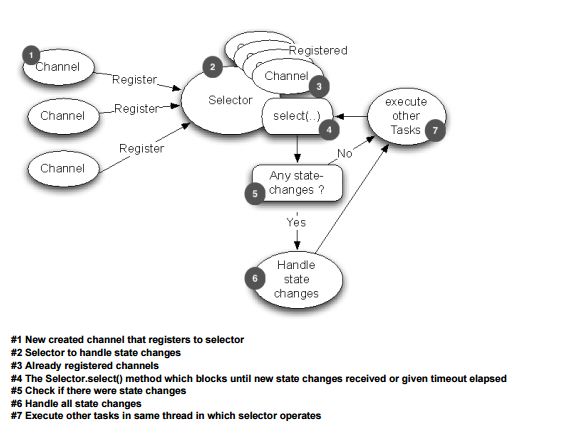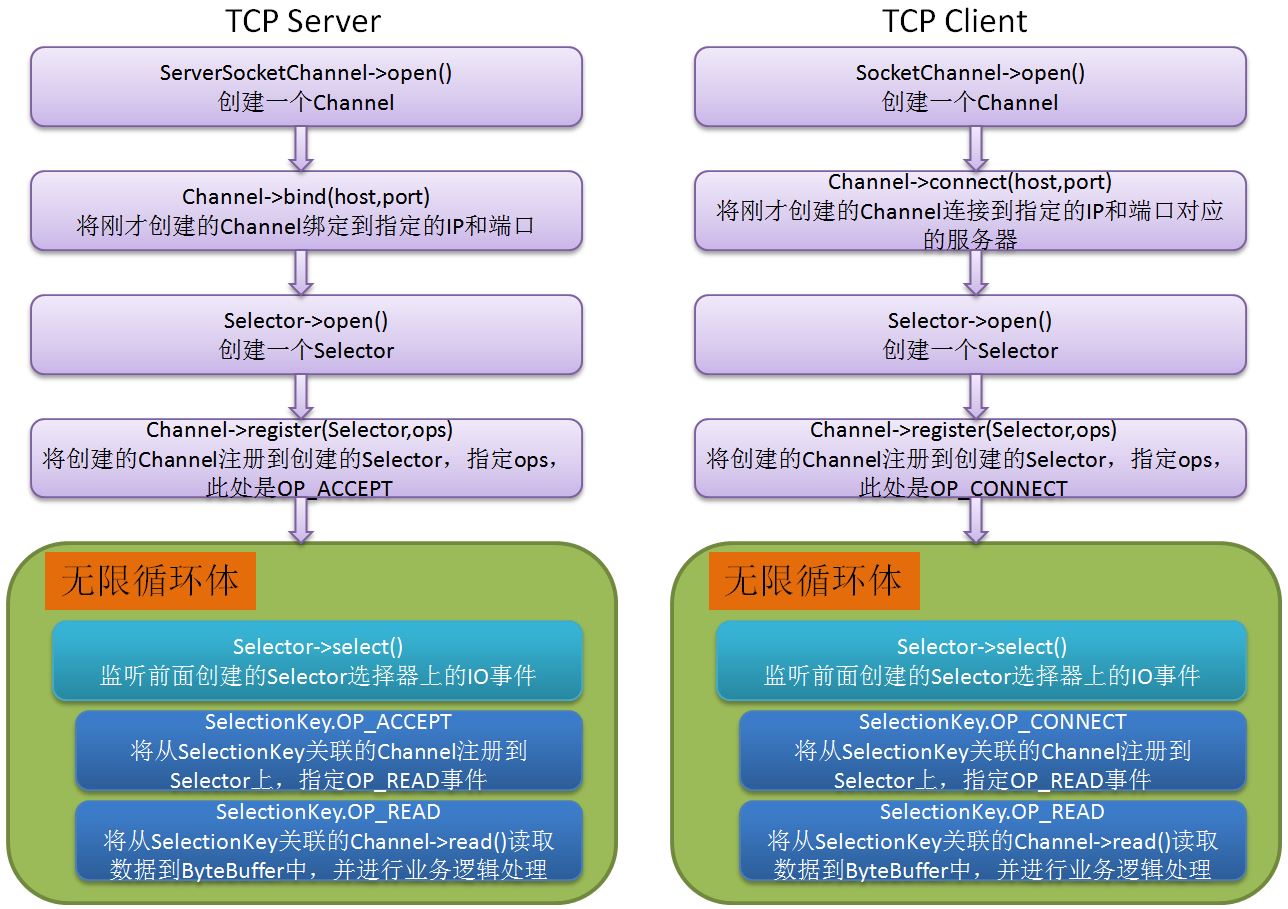Java NIO通信的基础,基于TCP C/S例子介绍
为了更好的理解Netty异步事件驱动网络通信框架,有必要先了解一点Java NIO原生的通信理论,下面将结合基于TCP的例子程序,含客户端和服务端的源码,实现了Echo流程。
Java NIO的核心概念有三个:Channel,Selector,ByteBuffer。
而这当中,Channel的比重最大,NIO的功能主要基于Channel来实现,进行业务逻辑操作。Selector主要是IO事件选择器,当一个Channel创建并配置好后,注册到Selector上,与Selector相关的重要概念是SelectionKey,这个上面绑定了IO事件相关的Channel。在获取到Channel后,进行数据的读写操作,Channel的数据读写是不能直接操作数据的,必须基于ByteBuffer进行,然而,Java NIO原生的ByteBuffer操作比较繁琐,要flip和clear操作。
1. 而我们在业务逻辑操作中,用到的channel,主要有ServerSocketChannel,SocketChannel,DataGramChannel。下面,用一个图,来简要的描述下Channel到这三个具体之类之间的继承/实现关系(该图来自网络,若有不妥,请告知,谢谢)。

2. Selector,是事件选择器,创建Selector后,在调用select之前,在注册Channel到这个Selector上时,必须指定关注的事件类型(interestOps)。通过这个类的select函数,可以获取选择上监听到的IO事件。一旦select函数检测到事件,就可以从Selector上获取到具体有哪些IO事件,这些事件通过SelectionKey承载,SelectionKey上标记出该事件的类型,比如是OP_CONNECT,OP_ACCEPT还是OP_READ等。另外,SelectionKey还记录了对应该IO事件发生的Channel,可以通过SelectionKey得到该Channel。

3. ByteBuffer。 因为字节操作,是操作系统与IO设备之间进行通信的基本数据单元,在Java NIO中,各通道Channel之间进行数据通信时,指定必须是基于ByteBuffer的。 ByteBuffer有两个重要的函数,flip和clear。当Channel调用read函数,将数据读到ByteBuffer中后,ByteBuffer的数据长度指针将会移动到数据长度所在的位置,这个位置是小于等于ByteBuffer容量capacity值的。当业务逻辑操作读取到的数据前,需要对ByteBuffer做一下flip操作,就是将limit指针指向当前数据指针position的位置,然后,将position指针指向0的位置。数据逻辑结束后,一般要恢复ByteBuffer,即调用clear函数。

这三个重要的概念,做了一番解释和描述后,就以一个demo程序,基于Java NIO的TCP C/S源码,代码中带有了重要逻辑的注释,后续不再单独解释。
A. TCP Server:
/**
* @author "shihuc"
* @date 2017年3月16日
*/
package javaSocket.tcp.server; import java.io.IOException;
import java.net.InetSocketAddress;
import java.nio.ByteBuffer;
import java.nio.channels.SelectionKey;
import java.nio.channels.Selector;
import java.nio.channels.ServerSocketChannel;
import java.nio.channels.SocketChannel;
import java.nio.charset.Charset;
import java.util.Iterator;
import java.util.Set; import javaSocket.tcp.Constants; /**
* @author chengsh05
*
*/
public class TcpServer { /**
* @param args
*/
public static void main(String[] args) {
try {
startServer(Constants.SERVER_PORT);
} catch (IOException e) {
e.printStackTrace();
}
} public static void startServer(int port) throws IOException{
/*
*开启一个服务channel,
*A selectable channel for stream-oriented listening sockets.
*/
ServerSocketChannel serverChannel = ServerSocketChannel.open();
serverChannel.configureBlocking(false);
serverChannel.bind(new InetSocketAddress(port)); /*
* 创建一个selector
*/
Selector selector = Selector.open();
/*
* 将创建的serverChannel注册到selector选择器上,指定这个channel只关心OP_ACCEPT事件
*/
serverChannel.register(selector, SelectionKey.OP_ACCEPT); while (true) {
/*
* select()操作,默认是阻塞模式的,即,当没有accept或者read时间到来时,将一直阻塞不往下面继续执行。
*/
int readyChannels = selector.select();
if (readyChannels <= ) {
continue;
} /*
* 从selector上获取到了IO事件,可能是accept,也有可能是read
*/
Set<SelectionKey> SelectonKeySet = selector.selectedKeys();
Iterator<SelectionKey> iterator = SelectonKeySet.iterator(); /*
* 循环遍历SelectionKeySet中的所有的SelectionKey
*/
while (iterator.hasNext()) {
SelectionKey key = iterator.next();
if (key.isAcceptable()) { //处理OP_ACCEPT事件
SocketChannel socketChannel = serverChannel.accept();
socketChannel.configureBlocking(false);
socketChannel.register(selector, SelectionKey.OP_READ);
} else if (key.isReadable()) { //处理OP_READ事件
SocketChannel socketChannel = (SocketChannel) key.channel();
StringBuilder sb = new StringBuilder();
ByteBuffer byteBuffer = ByteBuffer.allocate(); int readBytes = ;
int ret = ;
/*
* 注意读数据的时候,ByteBuffer的操作,需要flip,clear进行指针位置的调整
*/
while ((ret = socketChannel.read(byteBuffer)) > ) {
readBytes += ret;
byteBuffer.flip();
sb.append(Charset.forName("UTF-8").decode(byteBuffer).toString());
byteBuffer.clear();
} if (readBytes == ) {
System.err.println("handle opposite close Exception");
socketChannel.close();
} String message = sb.toString();
System.out.println("Message from client: " + message);
if (Constants.CLIENT_CLOSE.equalsIgnoreCase(message.toString().trim())) {
System.out.println("Client is going to shutdown!");
socketChannel.close();
} else if (Constants.SERVER_CLOSE.equalsIgnoreCase(message.trim())) {
System.out.println("Server is going to shutdown!");
socketChannel.close();
serverChannel.close();
selector.close();
System.exit();
} else {
String outMessage = "Server response:" + message;
socketChannel.write(Charset.forName("UTF-8").encode(outMessage));
}
}
/*
* 将selector上当前已经监听到的且已经处理了的事件标记清除掉。
*/
iterator.remove();
}
}
}
}
B. TCP Client
/**
* @author "shihuc"
* @date 2017年3月16日
*/
package javaSocket.tcp.client; import java.io.IOException;
import java.net.InetSocketAddress;
import java.nio.ByteBuffer;
import java.nio.channels.SelectionKey;
import java.nio.channels.Selector;
import java.nio.channels.SocketChannel;
import java.nio.charset.Charset;
import java.util.Scanner; import javaSocket.tcp.Constants; /**
* @author chengsh05
*
*/
public class TcpClient { /**
* @param args
*/
public static void main(String[] args) {
try {
startClient(Constants.SERVER_IP, Constants.SERVER_PORT);
} catch (IOException e) {
e.printStackTrace();
}
} public static void startClient(String serverIp, int serverPort) throws IOException{
/*
* 创建一个SocketChannel,指定为非阻塞模式
* A selectable channel for stream-oriented connecting sockets.
*/
SocketChannel socketChannel = SocketChannel.open();
socketChannel.configureBlocking(false); /*
* 连接到指定的服务地址
*/
socketChannel.connect(new InetSocketAddress(serverIp, serverPort)); /*
* 创建一个事件选择器Selector
*/
Selector selector = Selector.open(); /*
* 将创建的SocketChannel注册到指定的Selector上,并指定关注的事件类型为OP_CONNECT
*/
socketChannel.register(selector, SelectionKey.OP_CONNECT); /*
* 从系统输入终端读取数据,作为客户端信息输入源
*/
Scanner sc = new Scanner(System.in);
String cont = null;
while(true){
if(socketChannel.isConnected()){
cont = sc.nextLine();
socketChannel.write(Charset.forName("UTF-8").encode(cont));
if(cont == null || cont.equalsIgnoreCase(Constants.CLIENT_CLOSE)){
socketChannel.close();
selector.close();
sc.close();
System.out.println("See you, 客户端退出系统了");
System.exit();
}
}
/*
* 设置1sec的超时时间,进行IO事件选择操作
*/
int nSelectedKeys = selector.select();
if(nSelectedKeys > ){
for(SelectionKey skey: selector.selectedKeys()){
/*
* 判断检测到的channel是不是可连接的,将对应的channel注册到选择器上,指定关心的事件类型为OP_READ
*/
if(skey.isConnectable()){
SocketChannel connChannel = (SocketChannel) skey.channel();
connChannel.configureBlocking(false);
connChannel.register(selector, SelectionKey.OP_READ);
connChannel.finishConnect();
}
/*
* 若检测到的IO事件是读事件,则处理相关数据的读相关的业务逻辑
*/
else if(skey.isReadable()){
SocketChannel readChannel = (SocketChannel) skey.channel();
StringBuilder sb = new StringBuilder();
/*
* 定义一个ByteBuffer的容器,容量为1k
*/
ByteBuffer byteBuffer = ByteBuffer.allocate(); int readBytes = ;
int ret = ;
/*
* 注意,对ByteBuffer的操作,需要关心的是flip,clear等。
*/
while ((ret = readChannel.read(byteBuffer)) > ) {
readBytes += ret;
byteBuffer.flip();
sb.append(Charset.forName("UTF-8").decode(byteBuffer).toString());
byteBuffer.clear();
} if (readBytes == ) {
System.err.println("handle opposite close Exception");
readChannel.close();
}
}
}
/*
* 一次监听的事件处理完毕后,需要将已经记录的事件清除掉,准备下一轮的事件标记
*/
selector.selectedKeys().clear();
}else{
System.err.println("handle select timeout Exception");
socketChannel.close();
}
}
}
}
阅读上述代码时,请注意,server和client的实现风格不太一样,主要是针对SelectionKeySet的遍历,一次select操作获取到的所有的SelectionKey处理完后的扫尾工作,体现出Selector的工作逻辑,若写过C程序实现过TCP server/client程序,对事件选择的过程应该就更清楚了。
最后,总结一下Java NIO TCP协议下的C/S结构程序流程图,为彻底理解Java NIO服务。

基于这个例子引出的Java NIO的逻辑过程和思想,再去研读Netty的代码,相信会容易理解Netty的核心reactor模型工作原理。
最新文章
- git review & devops过程
- HTC One M7简易刷Recovery教程
- Mvc action间的传值
- SLAM中的EKF,UKF,PF原理简介
- 在Android的webview中定做js的alert,confirm和prompt对话框的方法
- Maven——使用Nexus搭建Maven私服
- test1
- Python基础-函数(function)
- Makefile.am讲解
- bzoj3293 [Cqoi2011]分金币&&bzoj1045 [HAOI2008]糖果传递
- Web中的性能优化
- 项目管理之 Git 管理软件 SourceTree for Mac
- 解决jenkins下使用HTML Publisher插件后查看html报告显示不正常 以jmeter报告为例
- hello world 为什么我们看到学习中有这一句话!!!
- IT题库7-线程加锁
- 基于mindwave脑电波进行疲劳检测算法的设计(3)
- :命令模式:Command
- Java FutureTask<V> 源码分析 Android上的实现
- Windows 7 手动添加受信任证书教程
- 消息队列第一篇:MessageQueue介绍